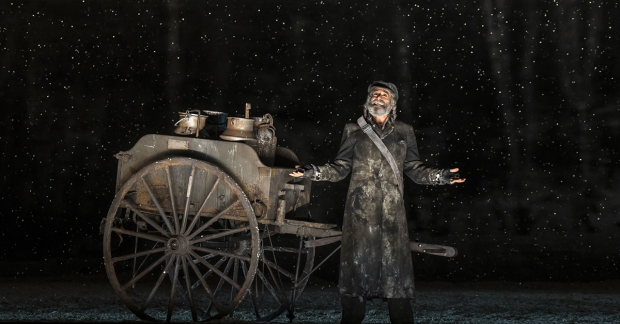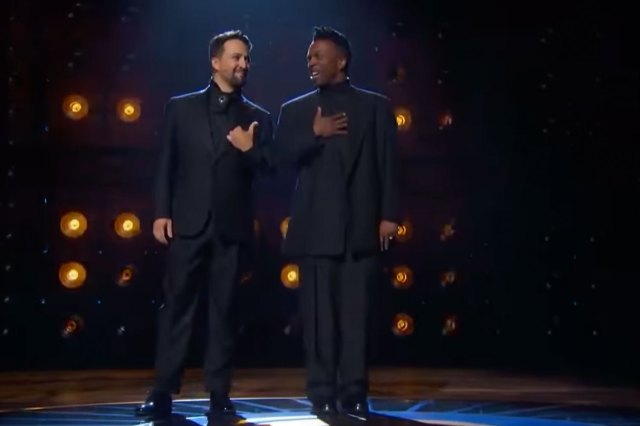Review: Steven Skybell Plays Tevye Again, This Time in English, in Lyric Opera's Fiddler on the Roof
The Chicago company brings a lauded German production to America, with an orchestra of over 60 players.

(© Todd Rosenberg Photography)
The Wall still divided Berlin when I visited in 1987, and its famous Komische Oper was in the Communist East. With no apparent sense of irony, the company achieved considerable success staging commercial Broadway musicals. The biggest hit of all, Fiedler auf dem Dach, had been in the repertory for 16 years by 1987. In reunified Germany 30 years later, Komische Oper Berlin scored again with Fiddler on the Roof (presented as Anatevka), staged by artistic director Barrie Kosky. That production is having its American premiere at Lyric Opera of Chicago, and the show's enduring values are intact—music, emotion, comedy, family, community, faith—as long as you forget the designs and physical realizations of all other Fiddler productions you've ever seen, including the film.
The musical values are superb and rich, with a vast orchestra (60-plus pieces, real strings, no keyboards) and opera-sized cast under conductor Kimberly Grigsby. Jerry Bock's familiar, redolent melodies never have sounded better from pit or stage. There's not a weak link among the singing principals, which is quite refreshing since Fiddler has a history of using vibrant performers of limited singing ability for some roles, most notably in the star turn of Tevye. It's wondrous, therefore, to enjoy the smooth, warm (even velvety) and expressive baritone of Steven Skybell in the role. Acclaimed for his portrayal of Tevye in the 2018-2020 off-Broadway Yiddish production (which he returns to in New York City in November), Skybell can daven like a cantor at one moment and pull off the show's humor the next, whether sly or broad.
The supporting principals chiefly are New York-based musical-theater veterans, among them Tony winner Debbie Gravitte (as Golde), Lauren Marcus (Tzeitel), Drew Redington (Motel), Austen Danielle Bohmer (Hodel), Adam Kaplan (Perchik), David Benoit (Lazar Wolf), and Joy Hermalyn (Yente). There's no fault to find with any of them, musically or dramatically. They bring joy to their characters in a frequently-somber story, and their fullness of feeling washes across the proverbial footlights, even in the enormous Civic Opera House. Kosky has fused them into a palpable community.
The dichotomy of Fiddler, of course, is joy, love and community in the face of impossible circumstances. The tale's dark side dominates almost all physical aspects of the production, except choreography (Silvano Marraffa). The Komische Oper Berlin design team has cloaked the production in a subdued, limited palette of blacks, grays, browns and some whites in the scenery (Rufus Didwiszuz), costumes (Klaus Bruns) and lighting (Diego Leetz original, recreated by Marco Philipp).
The basic set is a vast box of mottled grayish walls enclosing the sides and back of the stage. Act one begins with a curtain wall far downstage, showing a slightly-blurry birch forest. The wall is broken by a double-door wardrobe, from which Tevye and all of Anatevka emerge to sing "Tradition." Then, the curtain wall lifts to reveal a turntable with a 20-foot tall construction on it of piled-up wardrobes, mirror frames, settees and chairs. Turning to reveal different angles, it totally replaces all previous delineations of Anatevka, without a hint of Marc Chagall imagery, with brown-stained wardrobes standing in for village homes.

(© Todd Rosenberg Photography)
Not done yet, the designers completely abandon this huge sculpture in Act II, played start to finish in a heavy snowstorm on a nearly-empty stage. The birch forest drop is far upstage, with a single wardrobe in the snow downstage center, representing Tevye and Golde's house. As stunning as it is unexpected, Kosky and his team seem to have embraced Shakespeare's idea that A sad tale's best for winter" by bringing winter to the stage. Reinforcing this, the production cuts the Act II comedy crossover number, "The Rumor," which few will miss.
Particular credit is due to sound designer Peter Wiejaczka, who has mastered the considerable challenges of bringing clarity, proper balance and a natural sound to instrumental and vocal music and also dialogue. It's much better than previous Lyric musical theater productions.
Drake Wunderlich, a 10-year-old violinist, is also notable as the Fiddler, whose wordless role has been expanded beyond the opening and closing moments. Wunderlich dispatches his solos live onstage as a 21st century figure dressed in bright green (the show's only vivid costume). He opens the wardrobe doors at the start, as if the musty clothes within might bring to life an old story, which is precisely what happens.
One tiny problem: the cast and the Civic Opera House are so large, that sometimes one cannot tell who is speaking or singing, since we hear everything through the sound system and old-fashioned follow spots are not used (except for Tevye's interior monologues). Unlike traditional opera staging, Kosky does not always separate the key players from the ensemble.
This Fiddler is a once-in-a-generation reimagining of an iconic American musical, with messages about the unchanging nature of bigotry, and the ceaseless nature of change, which remain all too current for our contemporary world.








